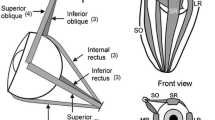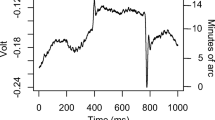Abstract
The chronological process of eye accommodation used when viewing objects was analysed to predict the size of viewed objects. Viewer’s visual evoked potentials (VEP), eye movements and pupil oscillations were measured while six sizes of Landolt circles were presented for 1s each. The significant features of the metrics were extracted to illustrate the perception process and the resulting sizes of visual stimuli. The stimulus sizes affect P1 and N1 delay times of VEP, means of eye movement lengths and pupil diameters and oscillations during the second 500 milliseconds of observation. The feasibility of prediction of stimulus sizes viewed was confirmed using the features of eye behaviour and support vector machines. Both indices of eye movements and pupil diameters were determined to be significant features for making predictions. The influences of the combination of features and viewer’s individual factors were also confirmed. This result suggests that features of oculo-motor indices reflect the size of objects being viewed and that these viewing sizes can be predicted using the features.














Similar content being viewed by others
References
Abe H, Nakayama M (2006) Event-related potential study of Kanji perception process. J Inst Image Inf Telev Eng 60:397–404
Bacon-Macé N, Kirchner H, Fabre-Thorpe M, Thorpe SJ (2007) Effects of task requirements on rapid natural scene processing: from common sensory encoding to distinct decisional machanisms. J Exp Psychol Hum Percept Perform 33:1013–1026
Blankertz B, Curio G, Müller K (2001) Classifying single trial EEG: towards brain computer interfacing. In: Proceedings of neural information processing symposium (NIPS). pp 157–164
Chang CC, Lin CJ (2001) LIBSVM: a library for support vector machines. Software available at URL: http://www.csie.ntu.edu.tw/~cjlin/libsvm
Christianini N, Shawe-Taylor J (2000) An introduction to support vector machines and Other Kernel-based learning mehods. Cambridge University Press, Cambridge
Crouzet SM, Kirchner H, Thorpe SJ (2010) Fast saccades toward faces: face detection in just 100 ms. J Vis 10:1–17
Devlaminck D, Wyns B, Boullart L, Sntens P, Otte G (2009) Brain-computer interfaces: from theory to practice. In: Proceedings of 17th European symposium on artificial neural networks (ESANN). pp 415–424
Duchowski AT (2006) High-level eye movement metrics in the usability context. Position paper, CHI2006 workshop: getting a measure of satisfaction from eyetracking in practice
Fujimoto M, Nakayama M (2011) Visibility for visual stimulus using visual evoked potentials. IEICE Trans Inf Syst J94-D:929–931
Grainger J, Holcomb PJ (2009) An ERP investigation of orthographic priming with relative-position and absolute-position primes. Brain Res 1270:45–53
Japan Society of Vision Science (ed) (2001) SHIKAKU JYOUHOU SYORI HANDOBUKKU (Handbook of Visual Information Processing) (In Japanese). Asakura Shoten, Tokyo
Kirchner H, Thorpe SJ (2006) Ultra-rapid object detection with saccadic eye movements: visual processing speed revisited. Vis Res 46:1762–1776
Maeda Y, Miyakawa M, Miyazawa Y, Hori J, Okamoto A, Ando N (2007) An attempt of a video magnifier controlled by the gazing information. IEICE Trans J90-D:715–723
Nakayama M, Fujimoto M (2011) Estimations of viewed object sizes using a single-channel of visual evoked potentials. In: Proceedings of 2011 IEEE symposium of computational intelligence for multimedia, signal and vision processing (CIMSIVP 2011). pp 98–105
Nakayama M, Fujimoto M (2012) Chronological accommodation of oculo-motors in response to varying sizes of visual stimuli. In: Proceedings of 2012 IEEE 11th international conference on trust, security, and privacy in computing and communications. pp 1513–1519
Niwa S, Tsuru N (eds) (1997) Jisho Kanren Deni (Event Related Potentials). Shinko Igaku Shuppan
Privitera CM, Stark LW (2000) Algorithms for defining visual regions-of-interest: comparison with eye fixations. IEEE Trans Pattern Anal Mach Intell 22:970–982
Rayner K (1998) Eye movements in reading and information processing: 20 years of research. Psychol Bull 124(3):372–422
Rugg MD (1997) Cognitive neuroscience. Psychology Press, UK
Shiba Y, Watabe H (1976) Toukeiteki Houhou II (Stastistical Method II). Shinyosha
Tatler BW, Wade NJ, Kwan H, Findlay JM, Velichkovsky BM (2010) Yabus, eye movements, and vision. i-Perception 1:7–27
Acknowledgments
Part of this study was presented at the 11th International Conference on Trust, Security and Privacy in Computing and Communication in Liverpool, UK, June 25-27th 2012. The authors would like to thank the reviewers for their comments.
Author information
Authors and Affiliations
Corresponding author
Rights and permissions
About this article
Cite this article
Nakayama, M., Fujimoto, M. Features of Oculo-motors and their chronological changes in response to varying sizes of visual stimuli. Multimed Tools Appl 74, 2841–2859 (2015). https://doi.org/10.1007/s11042-013-1824-y
Published:
Issue Date:
DOI: https://doi.org/10.1007/s11042-013-1824-y




